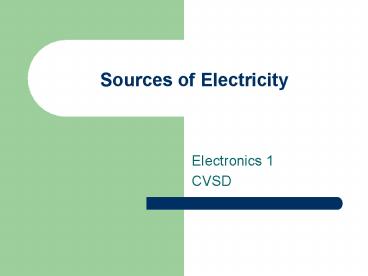Sources of Electricity - PowerPoint PPT Presentation
1 / 13
Title:
Sources of Electricity
Description:
Sources of Electricity ... Main principle behind solar cells (photo voltaic cell) Solar cells are made of silicon, when light waves hit the silicon ... – PowerPoint PPT presentation
Number of Views:76
Avg rating:3.0/5.0
Title: Sources of Electricity
1
Sources of Electricity
- Electronics 1
- CVSD
2
Resistance
- A measure of the opposition to the flow of
electrons through a material - Unit of Measurement
- Ohm (O)
- Symbol
- R
3
Voltage
- A measure of the Electromotive Force that pushes
electrons through a circuit (Potential
Difference) - Unit of Measurement
- Volt (V)
- Symbol
- E
4
Current
- A measure of the Intensity or total amount of
electrons flowing in a circuit in a given unit of
time - Unit of Measurement
- Ampere (A)
- Symbol
- I
5
Power
- A measurement of the rate of consuming energy,
transferring energy, or doing work - Unit of Measurement
- Watt (W)
- Symbol
- P
6
Six Sources of Electricity
- Chemical
- Magnetic
- Friction
- Pressure
- Heat
- Light
7
Chemical
- Uses unlike materials (electrodes) in a solution
(electrolyte) to form a voltaic cell - Cell Two electrodes with an
electrolyte in between - Battery Multiple cells strung
together in series /or
parallel circuits - Primary cell cannot be recharged
- Secondary cell can be recharged
- Cells can be wet or dry
(refers to electrolyte)
8
Magnetic
- Uses a conductor armature passing through a
magnetic field (lines of flux) - As the conductor cuts through the lines of
flux, a voltage is produced (electrons attracted
to or repelled by the field) - Used in generators
to convert
mechanical
energy into
electrical energy - Amount of current
produced
depends on speed
of armature of coils in the armature
9
Friction
- Electrical charge can be produced from rubbing
certain unlike materials together (electrons
transfer from one of the materials to the other) - Called static electricity
- The release of this static charge
results in a
static shock (lightning,
when you shock yourself
on metal, etc) - Friction between the touching
surfaces often causes
heat
(helps transfer electrons)
10
Pressure
- Some materials will transfer an external pressure
to their internal atoms, which drives their
electrons out of orbit (causing an electric
charge) - Most common material crystals
- Used in microphones and
phonograph pickups - Convert mechanical energy
into
electrical energy
11
Heat
- Two unlike pieces of metal joined together
produce electricity when heated - Called a thermocouple
- Current depends on the amount of heat types of
metals used - Converts thermal energy into electrical energy
- Used in conjunction with a ammeter to make a
pyrometer (measures high temperatures)
12
Light
- When light hits certain materials it releases
electrons, causing an electric charge. - Main principle behind solar
cells (photo voltaic cell) - Solar cells are made of
silicon, when
light waves
hit the silicon they
release
electrons - Convert light energy into
electrical energy - Amount of current depends on amount of light
13
Review
- Voltage is
- Current is
- Resistance is
- Power is
- What are the six sources of electricity?
- List the principle parts of a voltaic cell
- Lightning comes from which source?
- What is the difference between a primary and
secondary cell?































